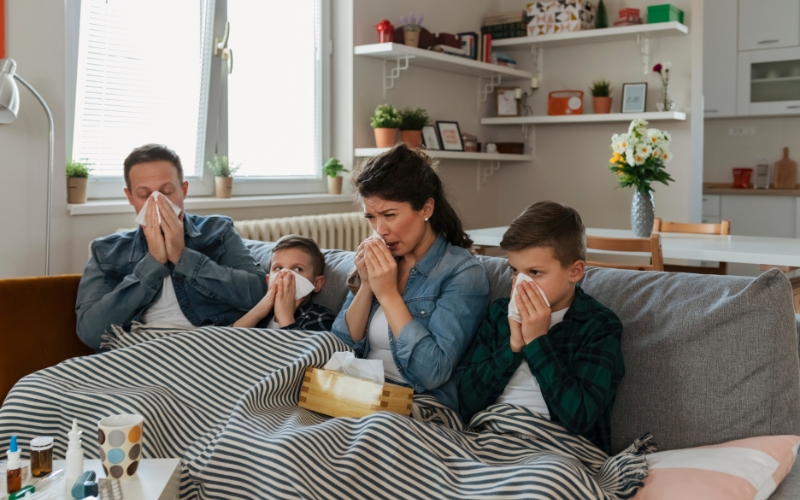There’s nothing like the buzz of a new school year. New supplies, new faces, new possibilities, and yet, as students come together, so do the germs that thrive in busy classrooms.
Maintaining a healthy school environment is critical, not just for preventing illness, but also for supporting students’ physical and mental well-being, both of which are essential for academic success. Synexis’ innovative Dry Hydrogen Peroxide technology is helping schools meet these challenges by enhancing environmental cleaning and disinfection in a powerful, continuous way.
The Ripple Effect of Illness: Absenteeism and Its Cost to Schools
The spread of germs in schools, combined with issues like poor air quality, can lead to illnesses such as colds, stomach bugs, asthma, and allergies. These health problems result in students and teachers missing valuable days of learning. For students, absenteeism is linked to lower academic achievement, increased risk of dropping out, and added strain on families who often must miss work to provide care.
Teachers are equally affected. A May 2022 U.S. Department of Education survey, conducted by the Institute for Education Sciences, reported a significant rise in teacher absences compared to previous years.1 Teacher absenteeism disrupts learning, lowers student motivation, increases behavioral issues, and decreases attendance overall. Substitute-led classes often see skipped classes and reduced participation, compounding the impact.
Viruses in Schools: Understanding the Risks
Schools are prime environments for the spread of respiratory and gastrointestinal (GI) viruses. Common cold viruses, like rhinoviruses and parainfluenza, spread easily through contaminated surfaces as well as respiratory droplets or fine aerosols released when an infected person coughs, sneezes, or even breathes.4 GI viruses, such as norovirus and rotavirus, are especially contagious and can survive on surfaces for long periods, fueling outbreaks in shared spaces.2
Among the most impactful viruses in recent history is SARS-CoV-2, the virus that causes COVID-19. Its effects have been far-reaching, to say the least. Outbreaks have occurred in school settings where air circulation and purification were inadequate. And because many infectious pathogens, including SARS-CoV-2, can be transmitted by individuals who do not show any visible symptoms, schools had to implement a comprehensive, layered approach to maintain a clean and safe environment, thereby safeguarding students, teachers, and staff.

Molds: The Hidden Allergen in Schools
Molds are a type of fungus that can infiltrate school buildings through poor maintenance, water leaks or spills, inadequate humidity control, condensation, or contaminated air. They thrive in damp, poorly ventilated areas, often going unnoticed until symptoms arise.
Mold exposure can trigger allergic reactions such as nasal congestion, dry cough, skin rashes, or eye irritation, and in some cases, can cause infections.3 For sensitive individuals, symptoms may escalate to wheezing, shortness of breath, and asthma attacks, especially in children.
Studies have shown that schools with mold issues often report significantly higher absenteeism rates, underscoring how indoor air quality directly impacts student health and academic performance.3
Bacteria in Schools
One of the most well-known bacteria associated with transmission in school settings is Methicillin-resistant Staphylococcus aureus (MRSA). MRSA often causes skin infections and can be particularly difficult to treat due to the bacteria’s resistance to many antibiotics. According to the Centers for Disease Control and Prevention (CDC), MRSA can survive for hours to weeks on surfaces such as towels, gym equipment, and shared athletic gear, making schools a high-risk setting. Infection occurs easily when contaminated objects come into contact with skin, especially cuts or open wounds.4
Volatile Organic Compounds (VOCs): The Invisible Pollutants in Classrooms
Volatile organic compounds, or VOCs, are another common yet often overlooked environmental hazard in schools. These compounds can be found in thousands of everyday products, including paint, craft supplies, furniture, cleaning products, and printers.5 Once indoors, these chemicals evaporate into the air as gases, contributing to indoor air pollution.
One of the most concerning aspects of VOCs is that they are often odorless, making them difficult to detect without proper monitoring. Long-term exposure to certain VOCs can affect respiratory health, irritate the eyes and skin, and even impair cognitive function.5
A Better Learning Environment: Continuous Protection Where It Matters Most
Educational spaces face ongoing risks of contamination from students, staff, and shared equipment. As the sole developer of Dry Hydrogen Peroxide (DHP®) technology, Synexis offers a powerful solution that addresses these hazards with our Synexis® Microbial Reduction System, providing continuous protection by actively reducing microbes in the air and on surfaces. Designed to operate before, during, and after traditional cleaning protocols, it delivers an uninterrupted layer of microbial defense, helping every classroom, cafeteria, and common area become a safer place to learn, teach, and thrive.
References
- S. Department of Education (2023, July). School Pulse Panel. Institute of Education Sciences. https://ies.ed.gov/schoolsurvey/spp/
- S. Department of Health and Human Services. (2024, May). School Preparedness: Preventing Spread of Infections in K-12 Schools. Centers for Disease Control and Prevention. https://www.cdc.gov/orr/school-preparedness/infection-prevention/index.html
- S. Environmental Protection Agency. (2025, July 24). Indoor Air Quality in Schools: Understanding IAQ Benefits. https://www.epa.gov/iaq-schools/evidence-scientific-literature-about-improved-academic-performance
- S. Department of Health and Human Services. (2025, June 27). Schools and Daycares: MRSA Prevention and Response. https://www.cdc.gov/mrsa/prevention/schools-and-daycares.html
- S. Environmental Protection Agency. (2025, July 24). Indoor Air Quality: Volatile Organic Compounds Impact on Indoor Air Quality. https://www.epa.gov/indoor-air-quality-iaq/volatile-organic-compounds-impact-indoor-air-quality#Health_Effects









